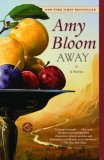Summary | Excerpt | Reading Guide | Reviews | Beyond the Book | Read-Alikes | Genres & Themes | Author Bio

A Novel
by Amy BloomThis article relates to Away
More than 200 Yiddish theatre troupes performed in the United States between 1890 and 1940 (photo of a theater group in 1909). In their heyday in the 1920s, twelve troupes resided in New York City alone, with 22 Yiddish theatres on the Lower East Side, the Bronx, and Brooklyn. Their repertoires spanned a variety of genres including operetta, musical comedy, revues, melodrama and Yiddish adaptations of Shakespeare. Audiences came to laugh and be entertained, but a vibrant literary culture also led to adaptations of Ibsen, Tolstoy, and Shaw running in Yiddish houses long before they appeared on Broadway. By the mid-1920s, Yiddish actors played to packed houses, many of their patrons solely English-speaking and paying Broadway prices for seats.
With roots in the satiric plays performed during the Jewish religious holiday of Purim*, the first Yiddish theatre troupe was likely founded in Romania in the 1870s by Abraham Goldfadn. Within a few years other troupes, playwrights, and critics popped up throughout Russia, enjoying success until Yiddish theatre was banned in 1883. Escaping the anti-Jewish persecution that followed Tsar Alexander II's assassination (1881), actors and playwrights fled to Western Europe and America. In New York, the Yiddish theatre first flourished in the late 1890s with many realistic plays that portrayed the divide between old country immigrants and their American-born children. By the 1920s, repertoires were increasingly based on great literary works like Shakespeare's King Lear, Ibsen's Hedda Gabler or Harriet Beecher Stowe's Uncle Tom’s Cabin.
Today, the 90-year-old New York basedFolksbiene theatre company still performs in Yiddish with English and Russian supertitles (large text is displayed above or next to the performers). Their repertoire combines classics and new pieces, children's theatre, and a traveling musical revue, seeking to provide a center for Yiddish culture, and teaching new generations about a remarkable aspect of Jewish history.
*The Jewish festival of Purim, which falls in February or March, celebrates the survival of the the Jews marked for death in 5th century BC Persia where, according to the Book of Esther, Haman, chief minister of King Ahasurerus, planned a general massacre of the Jews on a particular day selected by lottery (pur). The slaughter was averted when Esther interceded for the Jews and they were allowed to kill Haman and his family instead. Purim begins with a day of fasting, followed by a day of merrymaking and feasting, with gifts exchanged and donations given to the poor.
Filed under Places, Cultures & Identities
![]() This "beyond the book article" relates to Away. It originally ran in September 2007 and has been updated for the
June 2008 paperback edition.
Go to magazine.
This "beyond the book article" relates to Away. It originally ran in September 2007 and has been updated for the
June 2008 paperback edition.
Go to magazine.
Your guide toexceptional books
BookBrowse seeks out and recommends the best in contemporary fiction and nonfiction—books that not only engage and entertain but also deepen our understanding of ourselves and the world around us.